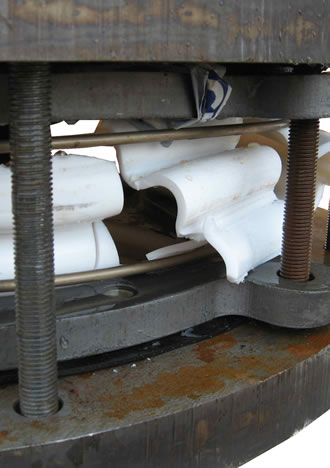Safety Testing
Bellows Safety Testing
Firstly we should state that there are no international standards for PTFE bellows, so the design, safety factors used, tests required etc are purely chosen by the manufacturer and as they don’t exist they don’t need to meet any standards. This means that bellows can be manufactured and supplied without any sort of testing and should be disconcerting to a prospective end user.
However the bellows manufactured by CRP have been subjected to several types of product testing to ensure that the data in our catalogues are accurate and based on actual product testing. The pressure ratings of our expansion bellows are higher than many other suppliers and this is because of our special design and carefully controlled and unique manufacturing techniques. All of the pressure temperature curves published are based on results of tests conducted on actual products.
Burst Pressure Tests
Here the bellows are pressurised with water at ambient temperature until the bellows rupture at pressures typically with a factor of 6 x the working pressure. Clearly these tests are very destructive to the bellows and expensive to fulfil but here at CRP we are committed to ensuring that our bellows will safely operate within the published parameters.

Here we have a DN 500 (20”NB) bellows after a burst pressure test
Long term bellows testing
Whilst burst pressure tests are very useful in plotting a pressure temperature curve they do not take into consideration the longer term effects of PTFE creep / cold flow, the effects of elevated temperatures and long term fatigue on the bellows. To consider and allow for these effects within our pressure / temperature curves CRP approached the TÜV in Germany to conduct tests on our bellows. These tests are based around the ISO 9080 standard titled ‘Plastic piping and ducting systems – Determination of the long term hydrostatic strength of thermoplastics materials in pipe by extrapolation. This test standard was considered the closest available match to PTFE bellows as they both exhibit similar fatigue at high temperatures and life spans.
With this test bellow are pressurized with the intention that they fail after a minimum of 9000 hours, to allow extrapolation of a 50 year life cycle. With this test many sets of bellows are pressurized to different pressures at different temperatures. The reason for the many pressures is that if a too high a pressure is chosen and the bellows fails too soon then the test is incomplete and would have to be restarted, likewise if the bellows is pressurized too low it may take many years or perhaps never for the bellows to fail and the test to be completed.
The different temperatures are used to accurately plot the pressure / temperature curve. CRP are still conducting theses tests on their bellows, our bellows are performing very well and perhaps better than we predicted so we are still waiting for news of failures from the test house. So far the lack of failures is only proving to confirm the published pressure / temperature curves.
Pressure Increase Tests
To try to ascertain the correct pressures for the long term pressure tests to be conducted at we again used the TUV in Germany to conduct the tests. Here bellows under test were held at two different temperatures of 100 and 150 degrees C. They were then subjected to a pressure increase of 0.25 bar per hour until the bellows ultimately failed. From the tests already conducted by the TUV it is known that there is a link between the results of the long term pressure tests and the pressure increase tests where with consistency the long term pressure tests were 16.5% below the pressure increase results. CRP have adopted this approach but using a 20% reduction to build in additional safety factor when plotting our pressure / temperature curves. This still gives a safety factor of x 2 at 50 years of life.
Vacuum Testing
Pressure ratings are only part of the story with PTFE bellows completely different forces effect a bellows under vacuum. CRP has conducted many tests on our bellows under the highest vacuum we can achieve at elevated temperatures up to 230 degrees C for many hours to ensure the bellows we produce perform as we publish in our catalogue. Bellows with 3 convolutions and up to 12” NB are suitable for use at 150 degrees C under full vacuum conditions with no need for any internal support rings. Bellows with 5 convolutions up to 6” NB are suitable for use up to 200 degrees C,

Here the images show a 12” NB bellows being successfully tested in the oven at 187 degrees C at nearly -0.9 barg vacuum
Factory Hydrostatic Testing
Finally each and every bellows manufactured is subjected to a final 1.5 x working pressure test at ambient temperature.
